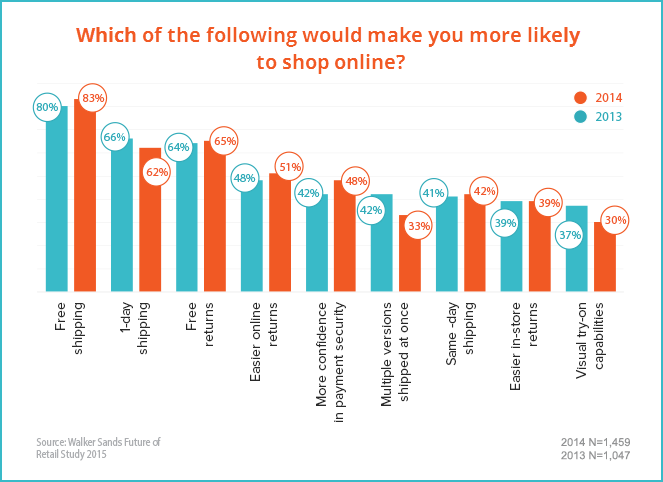by
Daniel Burstein, Director of Editorial Content
As part of the Walker Sands Future of Retail Study 2015, U.S. consumers were asked …
Q. Which of the following would make you more likely to shop online?
Click here to see a printable version of this chart
The 2013 responses were from a survey of 1,047 U.S. consumers, and the 2014 numbers represent data from 1,459 respondents.
As you look at the data, please understand that these were online consumers — for the 2014 data, nearly every respondent (99.8 percent) indicated they had made at least one Web purchase in the past year.
These are not physical retail consumers who might be enticed to buy online. These are customers already buying online. That said, this doesn't mean that 100% of their purchases are occurring online or from your store.
Let's see what we can learn from this data to help increase your ecommerce sales.
Free shipping is almost universally popular
An overwhelming majority of consumers (83%) say that free shipping would make them more likely to shop online, up from 80% one year ago. Free shipping is even more important than fast shipping — one-day shipping dropped in importance from last year (62% of customers citing it, down from 66% last year), and less than half of customers (42%) prioritize the much droned-on-about same-day shipping.
As classic direct-response marketers know, free is one of the most powerful words in marketing and advertising — if not in the English language itself.
However, consumers in general have become more skeptical and realize that most offers aren't actually free. In other words, there's a catch.
I believe that, because of free shipping, shoppers have become trained to understand exactly what free shipping means and don't feel tricked by the offer. That is:
- They obviously have to buy something (or there would be nothing to ship for free)
- There is likely some sort of minimum purchase required
- The shipping will (probably but not always) be relatively slow
There is a huge benefit to customers already understanding how this offer works — marketers can cut to the chase because they do not need to spend their marketing resources defining and selling the offer itself.
Because of this clarity and popularity, free shipping can help ecommerce sites:
- Compete with brick-and-mortar choices by lowering the cost of receiving the product below the brick-and-mortar cost (time it takes to visit the store, cost of gasoline or public transit, etc.)
- Gain business from price-sensitive shoppers (although, price comparison engines that show total cost can diminish this advantage)
- Entice customers to increase their order size by having a minimum required purchase for free shipping
- Perhaps paradoxically, can even encourage visits to brick-and-mortar locations, as more retailers make site-to-store their free shipping option
Free returns are growing in popularity as well
As ecommerce moves beyond the early adopters who tend to be satisfied with sub-optimal processes (e.g. buggy software) in exchange for being seen as cutting edge by their peer group, the mass market of customers expects a shopping experience to be as simple and trustworthy as brick-and-mortar shopping.
"[Customers are] gravitating toward ecommerce websites that offer the easiest and most convenient experience," said Dave Parro, Senior Account Director and Retail Technology Practice Lead, Walker Sands.
That expectation of ease and preference for companies that stand behind their products can be seen in the growth of free returns, which have risen to become the second-biggest element that would encourage consumers to shop online more.
While ecommerce sites use many tactics to reduce anxiety and communicate trustworthiness — from third-party credibility indicators to prominent customer service information to customer reviews — free returns are a clear indication that the company puts its money where its mouth is, so to speak, and is willing to take a financial hit unless the customer is pleased with the transaction.
"Reliability rules all. Trust is earned through good brand reputation and good past experiences in purchasing from the company," Parro said. "Amazon has effectively established this insurability with its customer base, and, as this relationship grew, word spread, to where the general public trusts the name for greater acquisition of the consumer market over time and retained customers from past shoppers seeing Amazon as a 'go-to' for their online buying needs."
This makes Amazon an excellent example for many of the ecommerce marketers reading this article … but also a significant threat. How can your ecommerce site compete with Amazon?
"It has become much more difficult to compete with one-stop-shop third parties on some products, but by garnering consumer trust and providing a unique experience … retailers may see added benefits," Parro concluded.
Related Resources
Subscribe to MarketingSherpa Chart of the Week — Gain access to the data and discoveries to help you better serve customers and improve marketing performance
Reinventing Retail: What businesses need to know for 2015 whitepaper (via Walker Sands)
U.S. Annual E-retail Sales Surpass $300 Billion for the First Time (by Allison Enright on Internet Retailer)
How Product Return System Lifted Conversions (Surprise) 26%Shipping Charges — How to Use Shipping Charges as a Marketing Tactic (a class experiment from the MarketingExperiments research directory)
Gourmet Tea Shop Cracks $1 Million in Online Sales Using 5 eRetail Best Practices (a classic case study from the MarketingSherpa library)










